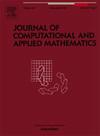A combined mixed finite element method and discontinuous Galerkin method for hybrid-dimensional fracture models of two-phase flow
IF 2.1
2区 数学
Q1 MATHEMATICS, APPLIED
Journal of Computational and Applied Mathematics
Pub Date : 2024-11-13
DOI:10.1016/j.cam.2024.116373
引用次数: 0
Abstract
In this paper, a combined numerical method consisting of the mixed finite element method (MFE) for the pressure equation and the discontinuous Galerkin (DG) method for the saturation equation is proposed to solve hybrid-dimensional fracture models of incompressible two-phase flow in porous media. The hybrid-dimensional fracture models treat fractures as -dimensional interfaces immersed in -dimensional matrix domains and take fluid exchange between fractures and surrounding matrix into account. Fully implicit approximation schemes combining the MFE-DG method with the backward Euler time discretization for the models with both a single fracture and an intersecting fractures network are all formulated successfully. The stability of the discrete solution is analyzed, and optimal error estimates in -norm for the velocity and in -norm for the pressure are derived, as well as in the discrete -norm for the saturation. Numerical experiments with a single fracture and a T-junction intersecting fractures network are conducted to verify the accuracy of our theoretical analysis.
两相流混合维断裂模型的混合有限元法和非连续伽勒金法组合
本文提出了一种混合有限元法(MFE)求解压力方程和非连续加勒金法(DG)求解饱和方程的组合数值方法,用于求解多孔介质中不可压缩两相流的混合维断裂模型。混合维断裂模型将断裂视为浸没在 d 维基质域中的 (d-1)-dimensional 界面,并考虑断裂与周围基质之间的流体交换。结合 MFE-DG 方法和后向欧拉时间离散法的全隐近似方案,成功地建立了单一断裂和相交断裂网络模型。分析了离散解的稳定性,得出了速度的 H(div)正态和压力的 L2 正态以及饱和度的离散 H1 正态的最佳误差估计值。为了验证我们理论分析的准确性,我们对单一裂缝和 T 型交汇相交裂缝网络进行了数值实验。
本文章由计算机程序翻译,如有差异,请以英文原文为准。
求助全文
约1分钟内获得全文
求助全文
来源期刊
CiteScore
5.40
自引率
4.20%
发文量
437
审稿时长
3.0 months
期刊介绍:
The Journal of Computational and Applied Mathematics publishes original papers of high scientific value in all areas of computational and applied mathematics. The main interest of the Journal is in papers that describe and analyze new computational techniques for solving scientific or engineering problems. Also the improved analysis, including the effectiveness and applicability, of existing methods and algorithms is of importance. The computational efficiency (e.g. the convergence, stability, accuracy, ...) should be proved and illustrated by nontrivial numerical examples. Papers describing only variants of existing methods, without adding significant new computational properties are not of interest.
The audience consists of: applied mathematicians, numerical analysts, computational scientists and engineers.

 求助内容:
求助内容: 应助结果提醒方式:
应助结果提醒方式:


